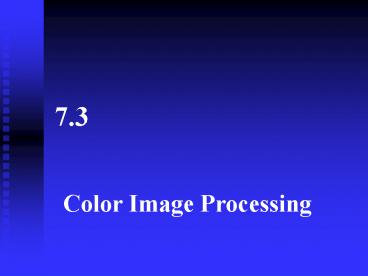Color Image Processing PowerPoint PPT Presentation
1 / 47
Title: Color Image Processing
1
7.3 ???????????????? Color Image Processing
2
(No Transcript)
3
- Color is a perceptual manifestation of light
which in turn is an electromagnetic signal. - Color is a sensation produced by the human eye
and nervous system.
4
(No Transcript)
5
Human Visual System
Detection
Processing
Exposure Control
Image formation
- Retina
- Rods
- Cones
- Brain
- Cornea
- Lens
- Iris/pupil
- Photoreceptor
- sensitivity
6
Human Eye
Ciliary Muscle
Sclera
Ear side (Temporal)
Iris
Vitreous Humor
Fovea
Pupil
Eyelens
Retina
Optic Nerve
Cornea
Nose side (Nasal)
Aqueous Humor
Choroid
Suspensory ligament
- Human eye is a complete imaging system.
7
Overwhelming experimental evidence tells us that
the perception of a color is related to the
strength of three signals which are transmitted
along the optic nerve to the brain.
8
(No Transcript)
9
(No Transcript)
10
7.3.1 Color Models
11
Color Model A "color model" is any method of
associating names or numbers with colors. The
importance of a color model is that it allows
communication about what color should be
produced.
12
- Examples include
- CMYK dot densities as reproduced by an offset
press, - RGB voltages sent to the electron guns of a
cathode ray tube display,
13
- CIE LAB numbers as measured by a "colorimeter",
or - Pantone color numbers as seen on the "swatch
books" published by that company.
14
- Color Model
- The international Commission on Illumination
(CIE, for Commison Internationale de lEclairage)
developed a device-independent color model based
on human perception. - Color representation consists in a reduction of
the spectral color space to a finite-dimensional
space.
15
1) The RGB (CMYK) Color Model
16
- RGB and its subset CMY form the most basic and
well-known color model. - This model bears closest resemblance to how we
perceive color. - It also corresponds to the principles of
additive and subtractive colors.
17
RGB Red, green, and blue are the primary
stimuli for human color perception and are the
primary additive colors. The relationship
between the colors can be seen in this
illustration
18
The secondary colors of RGB, cyan, magenta, and
yellow, are formed by the mixture of two of the
primaries and the exclusion of the third. Red
and green combine to make yellow, green and blue
make cyan, blue and red make magenta.
19
(No Transcript)
20
RGB(CYMK) Model
21
(No Transcript)
22
2) The HSV Color Model
23
The HSV (Hue, Saturation, and Value) color model
is more intuitive than the RGB color model. The
user specifies a color (hue) and then adds white
or black.
24
There are 3 color parameters Hue, Saturation,
and Value. Changing the saturation parameter
corresponds to adding or subtracting white and
changing the value parameter corresponds to
adding or subtracting black.
25
(No Transcript)
26
(No Transcript)
27
The HSB/HLS Color Model
28
In HSB, these are hue, saturation, and
brightness in HLS, they are defined by hue,
lightness, and saturation.
29
Hue defines the color itself, for example, red
in distinction to blue or yellow. The values
for the hue axis run from 0360 beginning and
ending with red and running through green, blue
and all intermediary colors like greenish-blue,
orange, purple, etc.
30
(No Transcript)
31
Saturation indicates the degree to which the hue
differs from a neutral gray. The values run from
0, which is no color saturation, to 100, which
is the fullest saturation of a given hue at a
given percentage of illumination.
32
Lightness indicates the level of illumination.
The values run as percentages 0 appears black
(no light) while 100 is full illumination, which
washes out the color (it appears white). In this
respect, the lightness axis is similar to
Munsell's value axis. Colors at percentages less
than 50 appear darker while colors at greater
than 50 appear lighter.
33
(No Transcript)
34
The Munsell Color System
35
Munsell modeled his system as an orb around
whose equator runs a band of colors. The axis
of the orb is a scale of neutral gray values with
white as the north pole and black as the south
pole.
36
Extending horizontally from the axis at each
gray value is a gradation of color progressing
from neutral gray to full saturation. With
these three defining aspects, any of thousands of
colors could be fully described. Munsell named
these aspects, or qualities, Hue, Value, and
Chroma.
37
(No Transcript)
38
Hue Munsell defined hue as "the quality by
which we distinguish one color from another."
He selected five principle colors red, yellow,
green, blue, and purple and five intermediate
colors yellow-red, green-yellow, blue-green,
purple-blue, and red-purple and he arranged
these in a wheel measured off in 100 compass
points
39
(No Transcript)
40
Value Value was defined by Munsell defined
value as "the quality by which we distinguish a
light color from a dark one." Value is a
neutral axis that refers to the grey level of the
color. This ranges from white to black.
41
Chroma Chroma is the quality that
distinguishes the difference from a pure hue to a
gray shade. The chroma axis extends from the
value axis at a right angle and the amount of
chroma is noted after the value designation.
42
(No Transcript)
43
(No Transcript)
44
(No Transcript)
45
7.3.2 Color descriptors
46
1. Color histograms
????????????????????????? tuple ltC, M,
Ci, H( Ci)gt ??? C ??? colar space, Ci
???? color quantization ??????????? I, M
?????????????? ??? H(Ci) Ni/N ??? Ni
???????????????????????????????
47
2. Color feature descriptor 3. Color names 4.
Color-induced sensations

